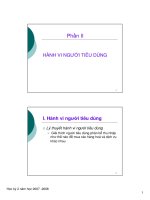Slide hành vi người tiêu dùng chapter9 group influence and opinion leadership
Bạn đang xem bản rút gọn của tài liệu. Xem và tải ngay bản đầy đủ của tài liệu tại đây (1.04 MB, 35 trang )
.c
om
Chapter 9
ng
th
an
co
ng
Group Influence and
Opinion Leadership
cu
u
du
o
CONSUMER
BEHAVIOR, 8e
Michael Solomon
CuuDuongThanCong.com
/>
Chapter Objectives
.c
om
When you finish this chapter you should understand
why:
ng
• Others, especially those who possess some kind of
co
social power, often influence us.
th
products or services.
an
• We seek out others who share our interests in
ng
• We are motivated to buy or use products in order to
du
o
be consistent with what other people do.
u
• The things that other consumers tell us about
cu
products (good and bad) are often more influential
than the advertising we see.
Hoang Duc Binh, 2008
CuuDuongThanCong.com
/>
Chapter Objectives (cont.)
.c
om
• Online technologies are accelerating the impact of
word-of-mouth communication.
and consumers interact.
co
ng
• Social networking is changing the way companies
th
an
• Certain people are particularly likely to influence
cu
u
du
o
ng
others’ product choices.
Hoang Duc Binh, 2008
CuuDuongThanCong.com
/>
Reference Groups
.c
om
• Reference group: an actual or imaginary
co
ng
individual/group conceived of having significant
relevance upon an individual’s evaluations,
aspirations, or behavior
cu
u
du
o
ng
th
an
• Influences consumers in three ways:
• Informational
• Utilitarian
• Value-expressive
Hoang Duc Binh, 2008
CuuDuongThanCong.com
/>
Reference Group Influences
.c
om
• Reference group influences stronger for purchases
cu
u
du
o
ng
th
an
co
ng
that are:
• Luxuries rather than necessities
• Socially conspicuous/visible to others
Hoang Duc Binh, 2008
Figure 11.1
CuuDuongThanCong.com
/>
When Reference Groups Are Important
co
ng
.c
om
• Social power: capacity to alter the actions of others
• Types of social power:
Information power
ng
th
an
Referent power
Expert power
cu
u
du
o
Legitimate power
Reward power
Coercive power
Hoang Duc Binh, 2008
CuuDuongThanCong.com
/>
Discussion
u
Expert power
du
o
Legitimate power
ng
Information power
th
Referent power
cu
•
•
•
•
•
•
an
co
ng
.c
om
High schools have all types of reference groups, with
members representing all types of social power.
Think back to high school and try to identify people
who had the following types of power (consider not
only peers but also teachers and administrators).
Reward power
Coercive power
Hoang Duc Binh, 2008
CuuDuongThanCong.com
/>
Types of Reference Groups
co
ng
Cultural figure
an
Parents
th
Large, formal organization
ng
Small and informal groups
• Exert a more powerful influence on individual
consumers
• A part of our day-to-day lives: normative influence
cu
u
du
o
•
•
•
•
.c
om
Any external influence that provides social clues can
be a reference group
Hoang Duc Binh, 2008
CuuDuongThanCong.com
/>
Brand Communities and Consumer Tribes
.c
om
• A group of consumers who
co
ng
share a set of social
relationships based upon usage
or interest in a product
an
• Brandfests enhance brand
ng
th
loyalty
du
o
• Consumer tribe share emotions,
cu
u
moral beliefs, styles of life, and
affiliated product
• Tribal marketing: linking a
product to the needs of a
group as a whole
Hoang Duc Binh, 2008
CuuDuongThanCong.com
/>
.c
om
Membership versus Aspirational
Reference Groups
Membership reference groups: people the
consumer actually knows
co
ng
• Advertisers use “ordinary people”
th
• Advertisers use celebrity
an
Aspirational reference groups: people the
consumer doesn’t know but admires
cu
u
du
o
ng
spokespeople
Click to view
Quicktime video on
use of celebrity
athletes in advertising
Hoang Duc Binh, 2008
CuuDuongThanCong.com
/>
Positive versus Negative Reference
Groups
.c
om
• Reference groups may exert either a positive or
negative influence on consumption behaviors
co
ng
• Avoidance groups: motivation to distance oneself
from other people/groups
th
an
• Marketers show ads with undesirable people using
ng
competitor’s product
du
o
• Antibrand communities: coalesce around a celebrity,
cu
u
store, or brand—but in this case they’re united by
their disdain for it
Hoang Duc Binh, 2008
CuuDuongThanCong.com
/>
Consumers Do It in Groups
.c
om
• Deindividuation: individual identities become
ng
submerged within a group
• Example: binge drinking at college parties
an
co
• Social loafing: people don’t devote as much to a task
du
o
ng
th
when their contribution is part of a larger group
• Example: we tend to tip less when eating in
groups
u
• Risky shift: group members show a greater
cu
willingness to consider riskier alternatives following
group discussion than if members mad their own
decisions
Hoang Duc Binh, 2008
CuuDuongThanCong.com
/>
Discussion
.c
om
• Do you agree that deindividuation encourages binge
drinking on campus?
co
ng
• What can or should a college do to discourage this
cu
u
du
o
ng
th
an
behavior?
Hoang Duc Binh, 2008
CuuDuongThanCong.com
/>
.c
om
Consumers Do It in Groups (cont.)
an
co
ng
Decision polarization: after
group discussion of an
issue, opinions become
more extreme
cu
u
du
o
ng
th
Home shopping parties
capitalize on group
pressure to boost sales
• Informational and
normative social influence
Hoang Duc Binh, 2008
CuuDuongThanCong.com
/>
.c
om
Discussion
co
ng
Home shopping parties—such as Tupperware, Avon,
Pampered Chef, Amway, or Botox—are designed to
put pressure on friends and neighbors to buy
merchandise.
du
o
Why or why not?
ng
th
an
• Have you attended these parties? Why or why not?
• Do you believe putting social pressure is ethical?
cu
women?
u
• Why are these parties more common among
Hoang Duc Binh, 2008
CuuDuongThanCong.com
/>
Conformity
ng
society’s expectations
regarding how to look/act
.c
om
• Most people tend to follow
•
u
membership
Group unanimity, size,
expertise
Susceptibility to
interpersonal influence
cu
•
du
o
ng
th
an
co
• Factors influencing conformity:
• Cultural pressures
• Fear of deviance
• Commitment to group
Hoang Duc Binh, 2008
CuuDuongThanCong.com
/>
.c
om
Word-of-Mouth Communication
co
More reliable form of marketing
an
Social pressure to conform
ng
th
Influences two-thirds of all sales
We rely upon WOM in later stages of product
adoption
du
o
•
•
•
•
ng
WOM: product information transmitted by individuals
to individuals
category
cu
u
• Powerful when we are unfamiliar with product
Hoang Duc Binh, 2008
CuuDuongThanCong.com
/>
Negative WOM and Power of Rumors
.c
om
• We weigh negative WOM more heavily than we do
cu
u
du
o
ng
th
an
co
ng
positive comments!
• Negative WOM is easy to spread, especially online
• Determined detractors
• Information/rumor distortion
Click photo for
Ihatestarbucks.com
Hoang Duc Binh, 2008
CuuDuongThanCong.com
/>
cu
u
du
o
ng
th
an
co
ng
.c
om
The Transmission of Misinformation
Hoang Duc Binh, 2008
Figure 11.2
CuuDuongThanCong.com
/>
Negative WOM and Power of Rumors
(cont.)
.c
om
Three basic themes found in Web-based “protest”
communities:
co
ng
• Injustice: consumers talk about their repeated
attempts to contact the company only to be ignored.
th
an
• Identity: posters characterize the violator as evil,
ng
rather than simply wrong.
du
o
• Agency: individual Web site creators try to create a
cu
u
collective identity for those who share their anger
with a company.
Hoang Duc Binh, 2008
CuuDuongThanCong.com
/>
Virtual Communities
.c
om
• A collection of people who share their love of a
ng
th
an
co
ng
product in online interactions
• Multi-user dungeons (MUD)
• Rooms (IRC), rings, and lists
• Boards
• Blogs/blogosphere
u
du
o
• Great potential for abuse via untrustworthy members
• Amazon.com lawsuit (charging publishers to post
cu
positive reviews of Web site)
Hoang Duc Binh, 2008
CuuDuongThanCong.com
/>
Virtual Communities
cu
u
du
o
ng
th
an
co
ng
.c
om
• Which type of Web surfer are you?
Hoang Duc Binh, 2008
Figure 11.3
CuuDuongThanCong.com
/>
Guerrilla Marketing
.c
om
• Guerilla marketing: promotional strategies that use
ng
unconventional locations and intensive WOM to
push products
cu
u
du
o
ng
th
an
co
• Recruits legions of real consumers for street theater
• Hip-hop “mix tapes”/street teams
• Brand ambassadors
Hoang Duc Binh, 2008
CuuDuongThanCong.com
/>
Viral Marketing
.c
om
• Viral marketing: getting visitors to a Web site to
ng
forward information on the site to their friends (for
product awareness)
u
du
o
ng
th
an
co
• Creating online content that is entertaining or weird
• Example: buzz campaign for Mini Cooper car
cu
Click photo for
Miniusa.com
Hoang Duc Binh, 2008
CuuDuongThanCong.com
/>
Social Networking and Crowd Power
.c
om
• Web sites letting members post information about
cu
u
du
o
ng
th
an
co
ng
themselves and make contact with similar others
• Share interests, opinions, business contacts
Click photo for Myspace.com
Click photo for
Facebook.com
Hoang Duc Binh, 2008
CuuDuongThanCong.com
/>









